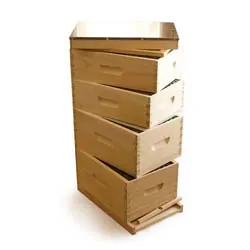Introduction
Having seen how to harvest honey from your beehives, there are more treasures awaiting you.
Honey gets all the good PR since everyone loves the stuff! But the comb in which that honey is stored and the caps on cells used to retain it are made of beeswax. With a little effort, it’s possible to extract this beautiful substance that can be used in so many creative ways.
The Many Uses of Beeswax
Before we look at how beeswax is created and how to collect it from your hives, it’s worth reflecting on the considerable number of ways in which it can be used. Beeswax is an incredibly versatile substance, with uses in food preparation, crafts, and much more. Here is a small list of ways in which we use beeswax:
- Food production
- Cosmetics
- Skincare
- Crafts
- Pharmaceuticals
- Health products
- Wood care products
- Waxing of products
- Seal for official documents
The list goes on and beekeepers harvest beeswax for these and many other reasons.
How Beeswax is Created
First, a quick recap on how bees create beeswax. Worker bees have eight pairs of wax glands under the abdomen, which produce tiny wax scales. The process of making comb involves the worker taking one of these wax scales, moving it to her front legs, and mixing it with saliva. This creates wax that is useful as a building material, namely for building comb.
The Properties of Beeswax
The utility and value we find in beeswax comes from its unique properties. These are evident in a substance that, apart from being created through a fascinating process, almost seems designed to be for our own benefit, though it is not, of course.
- Chemical composition. Beeswax is a complex substance. It is made up of well over 250 compounds, including long-chain alkanes, acids, esters, polyesters, and more. Hentriacontane forms around 9% of beeswax and affects its nature through its stability and impermeability to water.
- Insoluble in water. Beeswax is insoluble in water, which allows it to be used for many applications as a sealant.
- Melting point. Beeswax has a relatively low melting point of around 63 C. This means it is easy to transform from solid to liquid and vice versa, resulting in an agreeable substance for a wide range of applications.
- Clean burn. Beeswax has a clean, smokeless burn which, of course, is a key reason why it is used in candles. In fact, beeswax candles don’t just avoid polluting the air; many believe they help clean it. Beeswax releases negative ions when burned, helping attract airborne pollutants such as dust and dirt which carry a positive charge. This supposedly helps clean the air.
So these are the characteristics of beeswax. Let’s look at some of the methods for extracting it from our hives and frames.
Melt and Strain Method
Gather Cappings and Comb
We will assume relatively small amounts of wax are to be extracted i.e. this isn’t a commercial operation. Let’s look first at a simple process available to anyone with some simple tools in the kitchen.
Step one is to gather your wax. The cappings you gathered when harvesting honey are some of the best beeswax you can find! We place these in a cheesecloth. Also, if you are using foundationless frames then the comb is there for you, assuming you decide not to place it back in your hive. If you plan to use it to extract beeswax, then just break it into small pieces and place in another piece of cheesecloth.
At this point, you hopefully have plenty of beeswax, but it’s mixed in with all sorts of other gunk you don’t need. Let’s fix that.
Separate Wax
Place the beeswax-containing cheesecloth in a simmering saucepan of water. Gently press down to split up the larger chunks, which speeds things up a little as the beeswax melts.
Bring the water to a boil and when you have melted the beeswax in the water, squeeze out and remove the cheesecloth. This leaves behind “wax water”.
Pour that into a container and let it solidify, as it cools. The wax will rise to the top, with dirty water underneath. The solid layer on top is wax but is still quite dirty.
Clean Wax Cake
Take the solid wax cake that formed on the top of the water and once again melt it, this time in a double boiler. This creates a liquid that you can run through a filter again while still hot.
Pour Into a Mold
At this point, you have beautiful, clean, and melted wax. Pour into the mold of your choice and you are done.
Here’s a delightful video that illustrates one way to extract and use beeswax.
Solar Wax Melter
While the method described above works very well, it is also a multi-stage process and does tend to leave a rather strong aroma of beeswax in the kitchen (though it is quite pleasant). An alternative method that is commonly used is a solar max melter.
As the name implies, this simply uses the sun’s rays to create a very hot space in which the wax will melt and drain. This neat idea works very well. A solar wax melter is available from the PerfectBee Store, although many beekeepers make their own too.
Here is a video that illustrates the use of a solar wax melter.
Electric Wax Melter
Finally, for a high-end – and higher price – solution, electric wax melters are available. These are extremely convenient and allow the placement of frames inside, from which the wax is melted and subsequently drained.
